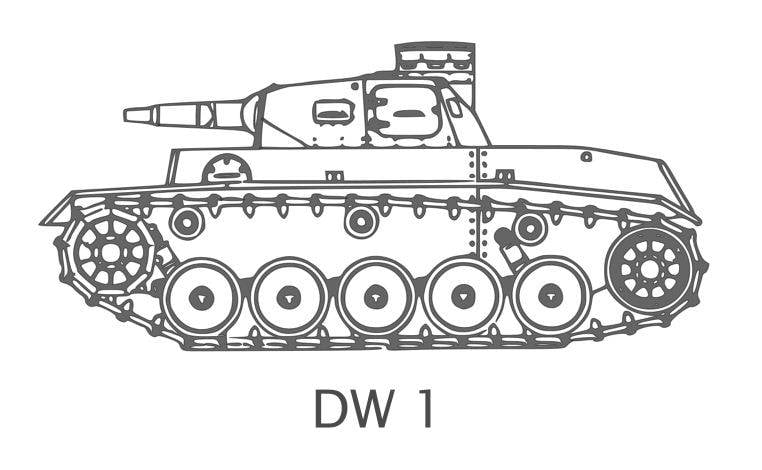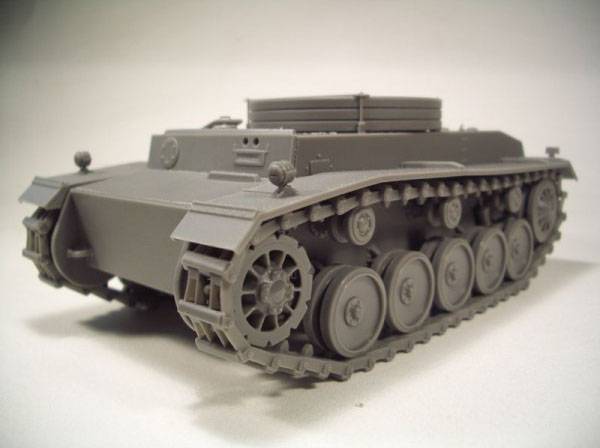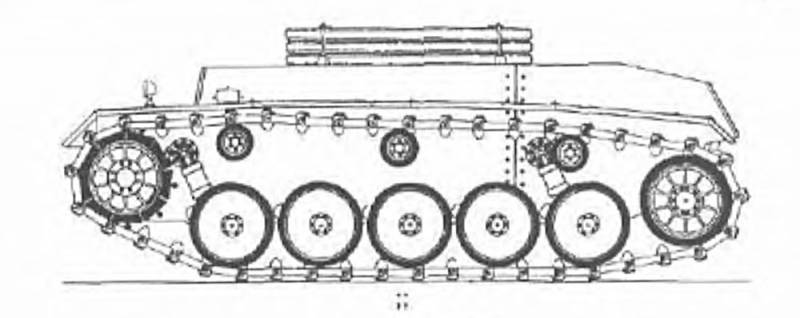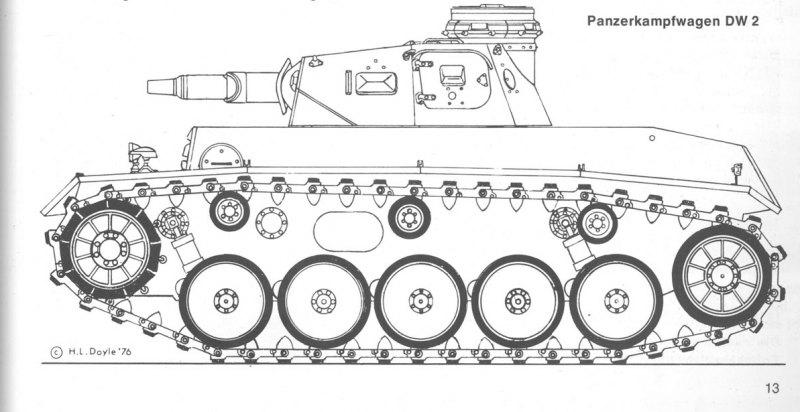Experimental heavy tanks Durchbruchswagen (Germany)
Work on the creation of heavy tanks began in January 1937 year. The Arms Administration ordered the industry to develop a new project with the subsequent construction and testing of a prototype machine. The contractor for the new project was Henschel. In the course of the new project, a number of major design and technological issues should be resolved. In addition, it was required to form the appearance of the car with the required characteristics. A prospective tank received the symbol DW I (Durchbruchswagen 1 - “Breakthrough tank, the first”). Also, some sources state that the prototypes of the Durchbruchswagen project also received the additional designation Pz.Kpfw.VI, which was subsequently assigned to the heavy tank “Tiger”.
DW I
Requirements for the new project DW I asked the basic parameters of a promising machine. Protection of the tank was to be armor plates with a thickness of 50 mm. This could lead to a significant increase in combat mass in comparison with the existing technology. The combat weight of the tank DW I should have exceeded the corresponding parameter of the average armored vehicle Pz.Kpfw.IV (50 t) by 18,4% and reached 25-30 t. Nevertheless, the main task of the first project “Tank breakthrough” was the creation and testing of a new chassis.
When creating the project DW I, Henschel's specialists had to face some production problems. Thus, the technical task required to create a tank with circular 50-mm armor, but the technology and production capabilities of the time did not allow to fully implement these plans. The main problems of this kind were related to the limitations imposed by the equipment of metallurgical plants on the dimensions of the parts produced. For this reason, in particular, it was not possible to perform the hull sides in the form of single parts of the required dimensions.
When creating a hull for a new heavy tank, the main ideas used in previous projects were used. It was decided to keep the front part of several sheets at an angle to each other. The top sheet was mounted almost vertically and was used to install crew viewing devices. Vertical sides were used, which had to be made from two parts. The first part of the board began in the frontal part of the hull and reached the stern of the crew compartment. The sides of the engine compartment were made of individual parts of the appropriate form.
Above the hull was covered with a horizontal roof. The stern part of the roof was inclined backwards and downwards. On the roof, it was originally proposed to put a shoulder strap to install the tower, but the fighting compartment for the tank was not developed. Therefore, instead of a tower on the roof of the hull, it was necessary to install several metal sheets of a corresponding mass, which were to serve as an imitator.
The body of the heavy tank I DW was proposed to be assembled from 50-mm armor plates of various shapes and sizes. The main part of the connections of parts was done by welding. The joint of the side parts behind the combat compartment was supposed to be assembled on rivets. A characteristic feature of such a hull was the same level of protection when firing from any angle. In addition, the idea of the body, consisting of several separate units, later received a certain development.
The project planned to use a well-developed layout of the corps, which had already become traditional for German tanks of various classes. In front of the car should have the transmission units, next to which there was a control compartment. The central part of the hull stood out under the fighting compartment, and in the stern it was proposed to place the engine. The engine compartment and transmission had to be connected using a cardan shaft passing through the fighting compartment.
In view of the large combat mass, the new chassis should have received a relatively powerful engine. It was proposed to install a Maybac HL 120 petrol engine with an 280 horsepower in the aft compartment. In front of the case were placed Maybach Variorex manual gearbox and Cletrac turning mechanism. Such a power plant had to ensure the rotation of the front drive wheels and give the car the required characteristics of mobility.

DW I scheme with turret from tank Pz.Kpfw.IV and 75-mm gun. Figure Wikimedia Commons
The chassis of the Durchbruchswagen 1 tank was to receive five support rollers of average diameter on each side. The rollers had an individual torsion bar suspension. In addition, the front and rear pairs of rollers should have received additional shock absorbers for amplification. In front of the hull were the drive wheels, located with a significant excess above the support rollers. In the stern there were guide wheels slightly raised above the supporting surface. There were also three pairs of support rollers. The tank was supposed to use a metal caterpillar 300 mm wide with a ridge engagement.
The size of the crew should depend on the type of weapons. However, DW I did not plan to equip a full-fledged fighting compartment, which should have led to various consequences. Inside the body of the armored vehicle was planned to place two jobs for tankers. In front of the hull, on the left side, was placed driver's seat. The driver had to get into the car through the hatch in the roof of the hull. In the front sheet was provided for viewing hatch.
To the right of the driver was the position of the gunner-radio operator. Like the driver, he had his own hatch in the roof, and in the frontal list was a machine gun installation. Also, the radio station of one of the existing models was to be in the right workplace of the department of management.
Powerful booking and use of ballast instead of a tower led to the fact that the full mass of the experimental DW I tank chassis reached 30 t. In this form, the project received customer approval, after which the construction of a prototype started. In the middle of 1937, the car came to the test, the platform for which was one of the German polygons.
According to the available data, the tests that lasted several months made it possible to determine both the advantages and the disadvantages of the new project. Certain problems with the existing transmission and its individual units were identified. Also criticized was the "team" hull design, created due to the lack of possibility of producing parts of the required dimensions. There were other comments that should be considered when further building heavy tanks.
During the tests, it was found that the existing 280-strong engine is capable of providing sufficiently high mobility characteristics, but in the future it might be necessary to replace the power plant. With a combat mass at the level of 30 t, the specific power of the tank was only 9,3 hp. per ton, which is why the maximum speed of the armored vehicle on the highway did not exceed 35 km / h. This satisfied the requirements that existed at that time, but in the future it was necessary to take measures aimed at increasing mobility.

The modern model of an experienced DW I chassis. Photo Webshop.lamaquette.be
Tests of an experienced tank I DW, according to various sources, continued until the middle of 1938 year. After that, it was decided to stop testing the first prototype and start creating a new armored vehicle with improved design and enhanced performance. The first prototype, the need for which was gone, was sent to the manufacturer, where he remained for some time.
DW II
The new version of the "Tank breakthrough" was to be an improved version of the previous DW I. A number of measures were proposed aimed at improving the design of the hull and transmission. In particular, during the work on the Durchbruchswagen industry, it was possible to develop technologies for the production of large-sized armor plates of the required thickness. This allowed us to optimize the design of the armored hull. In addition, new units and assemblies have appeared that could be used to improve the transmission. The updated tank was to receive the corresponding designation - DW II.
The general contours of the armored corps in the new project remained the same. The thickness of the armor has not changed either. In view of the emergence of new technologies, the hull sides were able to be made from single sheets, without any additional joints. Due to this, in particular, the hull received all-welded construction. Riveted joints of the main parts are no longer used.
The composition of the hatches on various parts of the armored hull has undergone some changes in the new project. For example, it was now proposed to install semi-circular hatches with movable covers instead of small gaps near the workplaces of the crew members located in the hull. Between the upper branch of the caterpillar and the second pair of road wheels, there were now additional hatches for evacuation.
Tank DW II retained the overall architecture of the power plant and transmission predecessor, and also had to be equipped with a similar engine. In this case, changes were made to the composition of the transmission, as well as refined its individual elements. Transformations have undergone the gearbox, final drives and the parking brake. The list of such changes was formed according to the results of tests of the first prototype.
General features of the chassis design remained unchanged, but some of its parts have been reworked. An independent torsion bar suspension was modified and reinforced. Also remade the drive wheels. The caterpillar design has undergone some modifications. Other parts of the chassis, as well as their location, remained the same.
The project DW II was not planned to develop a new tower for the installation of weapons. This unit was planned to borrow from the existing medium tank Pz.Kpfw.IV. Several armor plates of various shapes and thickness up to 50 mm should have been connected to each other and form a polygonal structure. The front sheet provided an embrasure for guns and machine guns, in the sides there were viewing instruments and hatches for boarding the car. In the stern of the tower also had a commander's turret.
Together with the turret, the entire armament complex was borrowed from the existing tank. The main weapon of the advanced heavy tank was to be the gun 7,5 cm KwK 37 L / 24. 75-mm gun was equipped with a short barrel length 24 caliber. The gun could accelerate the projectile to speeds of the order of 450 m / s and punch up to 35 mm of armor at a distance of 1 km (armor-piercing projectile). When using a cumulative ammunition, the thickness of the pierced armor reached 100 mm.
Additional armament of the tank was to consist of MG 7,92 34-mm machine guns. One of them was mounted in a common installation with a tool, and the second was placed in the embrasure of the front hull sheet. They should have been controlled by the gunner and the gunner-radio operator, respectively.
In 1939, a new prototype heavy tank was built and soon came to the test. According to various sources, in landing tests, a chassis equipped with a turret from a serial medium tank was used. Also there are references to the next use of metal blocks, which played the role of a weight tower simulator. Anyway, the experienced Durchbruchswagen 2 machine entered the training ground and showed its capabilities. In addition, it demonstrated the correctness or inaccuracy of the applied modifications.
The undoubted advantage of the new project was the use of solid sides that were not divided into two parts. In addition, the transmission and chassis refinements proved their worth. Similar changes were made as a result of testing a previous combat vehicle, and were also based on real experience, which allowed the project to be changed in the right way. General characteristics of the tank DW II, primarily indicators of mobility, remained at the same level. At the same time, the reliability of the equipment has increased, as well as its management has improved.
Results
In 1937-39, Henschel developed two projects for the promising heavy tanks of the Durchbruchswagen family. This technique came to the test and allowed to establish the prospects of those or other ideas and solutions underlying it. In addition, the emergence of two new projects has become a kind of incentive for the development of technologies for manufacturing armor with the necessary parameters.
From the very beginning, the projects DW I and DW II were not considered as a means of re-equipping the army. Only two experienced heavy tanks were built, which were tested and then returned to the manufacturer. About serial construction of the speech did not go. For some time, two prototypes remained on one of the sites of the Henschel plant, but later they were disassembled and sent to the smelter as superfluous.
In the near future, based on the ideas laid out and tested in the framework of the Durchbruchswagen project, several new variants of promising armored vehicles were created. The first of the new tanks were VK 3001 (H) and VK 3001 (P) from Henschel and Porsche, respectively. Further development of this technique, which led to the emergence of several more projects, eventually allowed Germany to create the required heavy tank, which went into series and entered the army. However, before that there were still a few years.
Based on:
http://armor.kiev.ua/
http://pancerium.pl/
http://aviarmor.net/
Chamberlain P., Doyle H. Complete reference book of German tanks and self-propelled guns of the Second World War. - M .: AST: Astrel, 2008.
Baryatinsky M.B. Heavy tank "Tigr" // Armored collection. 1998. No.6.


Information